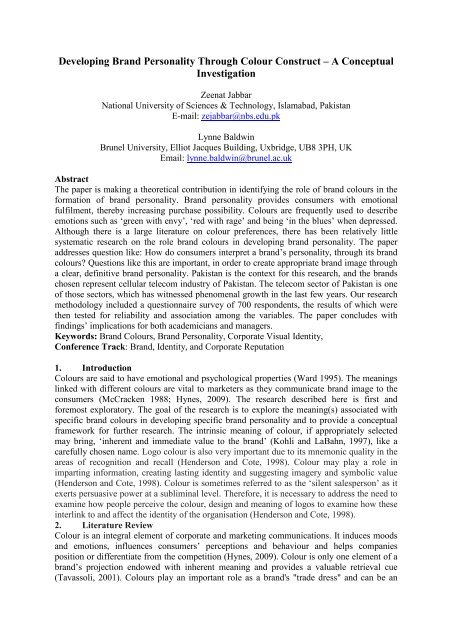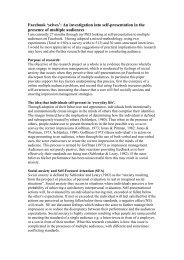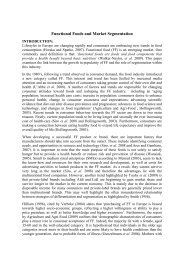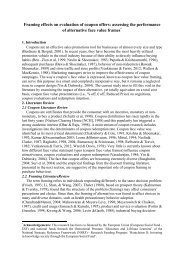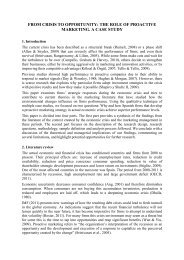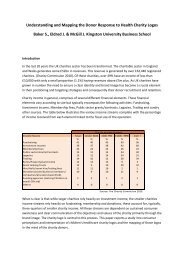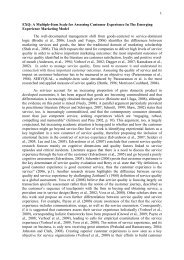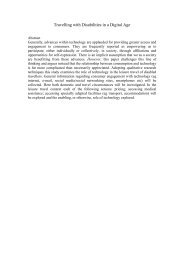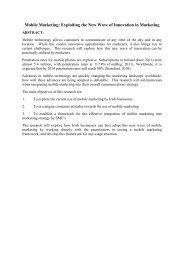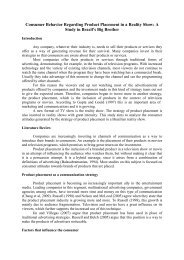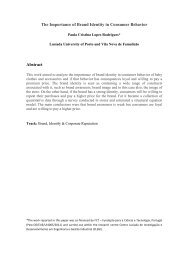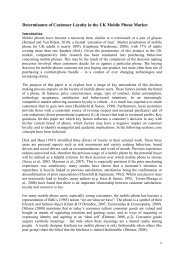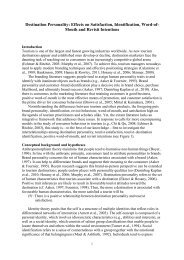Developing Brand Personality Through Colour Construct – A ...
Developing Brand Personality Through Colour Construct – A ...
Developing Brand Personality Through Colour Construct – A ...
You also want an ePaper? Increase the reach of your titles
YUMPU automatically turns print PDFs into web optimized ePapers that Google loves.
<strong>Developing</strong> <strong>Brand</strong> <strong>Personality</strong> <strong>Through</strong> <strong>Colour</strong> <strong>Construct</strong> <strong>–</strong> A Conceptual<br />
Investigation<br />
Zeenat Jabbar<br />
National University of Sciences & Technology, Islamabad, Pakistan<br />
E-mail: zejabbar@nbs.edu.pk<br />
Lynne Baldwin<br />
Brunel University, Elliot Jacques Building, Uxbridge, UB8 3PH, UK<br />
Email: lynne.baldwin@brunel.ac.uk<br />
Abstract<br />
The paper is making a theoretical contribution in identifying the role of brand colours in the<br />
formation of brand personality. <strong>Brand</strong> personality provides consumers with emotional<br />
fulfilment, thereby increasing purchase possibility. <strong>Colour</strong>s are frequently used to describe<br />
emotions such as ‘green with envy’, ‘red with rage’ and being ‘in the blues’ when depressed.<br />
Although there is a large literature on colour preferences, there has been relatively little<br />
systematic research on the role brand colours in developing brand personality. The paper<br />
addresses question like: How do consumers interpret a brand’s personality, through its brand<br />
colours? Questions like this are important, in order to create appropriate brand image through<br />
a clear, definitive brand personality. Pakistan is the context for this research, and the brands<br />
chosen represent cellular telecom industry of Pakistan. The telecom sector of Pakistan is one<br />
of those sectors, which has witnessed phenomenal growth in the last few years. Our research<br />
methodology included a questionnaire survey of 700 respondents, the results of which were<br />
then tested for reliability and association among the variables. The paper concludes with<br />
findings’ implications for both academicians and managers.<br />
Keywords: <strong>Brand</strong> <strong>Colour</strong>s, <strong>Brand</strong> <strong>Personality</strong>, Corporate Visual Identity,<br />
Conference Track: <strong>Brand</strong>, Identity, and Corporate Reputation<br />
1. Introduction<br />
<strong>Colour</strong>s are said to have emotional and psychological properties (Ward 1995). The meanings<br />
linked with different colours are vital to marketers as they communicate brand image to the<br />
consumers (McCracken 1988; Hynes, 2009). The research described here is first and<br />
foremost exploratory. The goal of the research is to explore the meaning(s) associated with<br />
specific brand colours in developing specific brand personality and to provide a conceptual<br />
framework for further research. The intrinsic meaning of colour, if appropriately selected<br />
may bring, ‘inherent and immediate value to the brand’ (Kohli and LaBahn, 1997), like a<br />
carefully chosen name. Logo colour is also very important due to its mnemonic quality in the<br />
areas of recognition and recall (Henderson and Cote, 1998). <strong>Colour</strong> may play a role in<br />
imparting information, creating lasting identity and suggesting imagery and symbolic value<br />
(Henderson and Cote, 1998). <strong>Colour</strong> is sometimes referred to as the ‘silent salesperson’ as it<br />
exerts persuasive power at a subliminal level. Therefore, it is necessary to address the need to<br />
examine how people perceive the colour, design and meaning of logos to examine how these<br />
interlink to and affect the identity of the organisation (Henderson and Cote, 1998).<br />
2. Literature Review<br />
<strong>Colour</strong> is an integral element of corporate and marketing communications. It induces moods<br />
and emotions, influences consumers’ perceptions and behaviour and helps companies<br />
position or differentiate from the competition (Hynes, 2009). <strong>Colour</strong> is only one element of a<br />
brand’s projection endowed with inherent meaning and provides a valuable retrieval cue<br />
(Tavassoli, 2001). <strong>Colour</strong>s play an important role as a brand's "trade dress" and can be an
influential communicative device (Meyers-Levy & Peracchio, 1995). <strong>Colour</strong> influences<br />
human emotions or feelings, in the sense that some colours may make one happy, while some<br />
colours may make one depressive. Simultaneously, colour itself has some characteristics,<br />
which can be described by semantic words, such as ‘‘warm<strong>–</strong>cool,’’ ‘‘light<strong>–</strong>dark,’’ ‘‘soft<strong>–</strong><br />
hard,’’ etc. The semantic words describing the characteristics of colours and human’s<br />
emotional responses on colours are generally termed as colour emotion (Nakamura et al,<br />
1994; Sato et al, 2000a; Sato et al, 2000b; Xin et al, 1998). Table 1 below gives a brief<br />
description of how colours are associated with different emotions, linked to personality, as<br />
researched in two separate studies.<br />
Table 1: Typology of <strong>Colour</strong> Associations<br />
COLOURS Hynes (2009) Clarke & Costall (2008)<br />
<strong>Colour</strong> Connotation <strong>Colour</strong> Connotation<br />
Blue Protective, Stability, Prestigious, Secure,<br />
Reliable Grow<br />
Purple Passionate, Playful, Visionary, Truth, Justice<br />
Exciting<br />
Orange Fun, Playful, Happy Fun, Playful, Happiness<br />
Red Fun, Playful, Happy Passionate, Dynamic,<br />
Exciting<br />
Yellow Fun, Energetic, Happy Energetic, Cheerful,<br />
Imaginative, Cheerful Friendly<br />
Green Stability, Contemplative Fun, Energetic, Healthy<br />
Pink Truth, Justice Protective, Homely,<br />
Stable<br />
Brown Homely, Dependable, Earthly, Nature<br />
Warm<br />
<strong>Brand</strong> personality provides consumers with emotional fulfilment, thereby increasing purchase<br />
possibility (Freling and Forbes 2005). The usefulness of brand personality is conclusive; as<br />
long as the brand personality is perceived to be strong and favourable, the consequences, such<br />
as brand associations and evaluation, are positive (Freling and Forbes 2005). <strong>Brand</strong><br />
personality is important especially for differentiation and developing the emotional aspects of<br />
the brand (Plummer 1985, D.Aaker 1996, Aaker 1997, Diamantopoulos et al, 2005, Freling<br />
2005, , Bosnjak et al, 2007). <strong>Colour</strong> is a vital part of products, services, packages, logos,<br />
displays and collateral. It is a potent cue for product and brand differentiation and for creating<br />
and sustaining corporate identities (Garber and Hyatt, 2003; Madden et al., 2000) and<br />
consumer perceptions (Grossman and Wisenblit, 1999). <strong>Colour</strong> signals a product’s attributes<br />
for merchandise, thereby influencing perceptions about price and quality (Kerfoot et al.,<br />
2003). <strong>Colour</strong> is the least expensive way of changing the product (Parmar, 2004). <strong>Colour</strong><br />
distinctiveness within a category or ‘visual branding’ allows for visual brand differentiation.<br />
<strong>Colour</strong> also facilitates ‘emotional branding’ and companies could use colours associated with<br />
specific emotions in order to target the psychogenic heterogeneity of the market (Moser,<br />
2003). <strong>Colour</strong> is an important brand attribute that coveys different symbolic meanings, which<br />
are employed in the creation and maintenance of brand images (Madden et al., 2000), as a<br />
tool for advertising persuasiveness (Myers-Levy and Peracchio, 1995), and influence<br />
purchase decision for products (Eckman et al., 1990; Cooper, 1994). Such studies have
looked beyond the aesthetic value of colour and investigated its functional value. This<br />
functional value originates from specific meanings that colours convey in different contexts<br />
and has implications for psychological functioning; their studies demonstrate that the mere<br />
perception of the colour evokes affect, cognition, and behavior congruent to the meaning<br />
(Elliot et al, 2007). Cool colours such as green, blue, and white clustered together are<br />
associated with gentle, peaceful, and calming meanings; whereas, warm colors such as<br />
yellow, gold, orange, red, and purple clustered together and are associated with vibrant, hot,<br />
active, and sharp meanings (Madden et al, 2000). Recent research on brand personality<br />
defines the construct as “the set of human characteristics associated with a brand” and<br />
documents a stable set of personality dimensions that are thought to underlie the construct<br />
(Aaker, 1997)<br />
• sincerity, typified by traits such as wholesome, down-to-earth, and honest;<br />
• excitement, typified by traits such as daring, imaginative, and exciting;<br />
• competence, typified by traits such as intelligent, secure, and confident;<br />
• sophistication, typified by traits such as glamorous, smooth, and charming; and<br />
• ruggedness, typified traits such as strong, masculine, and western.<br />
<strong>Brand</strong> personality scale (BPS) measures, as proposed by Aaker (1997), the extent to which a<br />
given brand possesses any of these personality traits. <strong>Brand</strong> personality influences<br />
consumers’ perceptual processing of product information. <strong>Brand</strong> personality is a nonphysical<br />
piece of product knowledge that shapes perceptions about that product and deals with the<br />
importance of relations in social activities and gives the brand higher positions in the mind of<br />
consumers and makes the brand as their friends and belongings (Rajagopal, 2006); and it is<br />
all the attitudes, perspectives, feelings and views customers have about a brand. <strong>Brand</strong><br />
associations are important to marketers and to consumers. Marketers use brand associations<br />
to differentiate, position, and extend brands, to create positive attitudes and feelings toward<br />
brands, and to suggest attributes or benefits of purchasing or using a specific brand.<br />
Consumers use brand associations to help process, organize, and retrieve information in<br />
memory and to aid them in making purchase decisions. Another advantage of the personality<br />
association is that it establishes direct relationship with the customers (Taft, 1997). Therefore,<br />
we propose the following hypothesis:<br />
H1: <strong>Brand</strong> colour blue is associated with the personality trait, competence (intelligence,<br />
secure, & confident);<br />
H2: <strong>Brand</strong> colour purple is associated with personality trait, sophistication (glamorous,<br />
smooth, & charming);<br />
H3: <strong>Brand</strong> colour orange is associated with personality trait, excitement (daring,<br />
imaginative, & exciting);<br />
H4: <strong>Brand</strong> colour red is associated with personality trait, sincerity (wholesome, down-toearth,<br />
& honest).<br />
3. Research Methodology<br />
Our sample frame includes 700 Pakistani youth, with an age bracket of 18-26, who<br />
constitutes the highest usage of cellular services in Pakistan (Pakistan Telecom Authority,<br />
2011), the sampling method used is stratified random sampling. We analysed brand colours’<br />
impact on developing brand personalities of five telecom companies operating in Pakistan,<br />
The brands include: Mobilink, Telenor, Ufone, Warid, and Zong. Mobilink’s brand colour is<br />
purple, Telenor’s brand colour is blue, Ufone’s brand colour is orange, Warid’s brand colour<br />
is red, whereas, Zong does not have any one predominant brand colour, instead it is a<br />
combination of yellow, red, and blue. We used a questionnaire survey, wherein, the questions
were adapted from research sources available in the relevant literature, including<br />
Karaosmanoglu (2006), Clarke and Costall (2008), Hynes (2009), Aaker (1997). The<br />
geographic location of the survey was the twin cities of Islamabad and Rawalpindi. A fivepoint<br />
likert scale (ranging from ‘strongly disagree’ to ‘strongly agree’) was used. SPSS 16.0<br />
software was used to analyse the data, the variables used and their respective codes are listed<br />
in Table 2.<br />
Table 2: List of Variables & their SPSS Code<br />
Variables SPSS Code<br />
Blue represents Competence, Intelligent, Secure, Confident BCISC<br />
Red represents Sincerity, Wholesome, Down-to-Earth,<br />
Honest<br />
RSWDH<br />
Orange represents Excitement, Daring, Imaginative OEDI<br />
Purple represents Sophistication, Smooth, Glamourous,<br />
Charming<br />
The brand colours of the company communicates what it<br />
stands for<br />
PSSGC<br />
CCOM<br />
I like the brand colours of the company LCOL<br />
The brand colours of the company are easily recognized RCOL<br />
The brand colours of the company make me have positive feelings<br />
towards the company<br />
We used Cronbach Alpha to test the reliability factor, and Pearson Chi-square to test the<br />
association among the constructs. The Cronbach alpha value for all the 8 items generated<br />
under this research study, is 0.859, hence, there exists a greater internal consistency among<br />
the items on the scale. We also used Pearson Chi-Square in order to establish the strength of<br />
the relationship between the cross-tabulated variables. A chi-square value of less than .05<br />
signifies an existence of a stronger relationship. The values presented in Table 3 prove that a<br />
strong relationship exists between the cross-tabulated variables.<br />
PCOL<br />
Table 3: Measure of Association among Variables<br />
<strong>Construct</strong>s Variables Pearson Chi-Square<br />
<strong>Brand</strong> Name with <strong>Brand</strong> <strong>Brand</strong> names crosstab BCISC, RSWDH, OEDI, PSSGC 0.003<br />
<strong>Personality</strong> <strong>Brand</strong> names crosstab CCOM, 0.012<br />
LCOL, RCOL & PCOL<br />
<strong>Brand</strong> names crosstab competence, sincerity,<br />
excitement, and sophistication 0.001<br />
Table 3 presents strength of associations between brand names (Mobilink, Telenor, Ufone,<br />
Warid, and Zong) and different colours representation (BCISC, RSWDH, OEDI, & PSSGC);<br />
brand colours association with brand personality traits ‘competence’, ‘sincerity’,<br />
‘sophistication’ and ‘excitement’ is tested; similarly brand names association with brand<br />
colours’ preference is also tested. The demographic distribution of the sample was as follows:<br />
85% were undergraduate and 15% were postgraduate students (595 undergraduate and 105
postgraduate respectively); 54% were male and 46% were female (378 male and 322 female);<br />
52% resided in Islamabad and 48% resided in Rawalpindi (364 from Islamabad and 336 from<br />
Rawalpindi); the age group was divided into three age brackets: 18-20 (504; 72%), 21-23 (91;<br />
13%), and 24-26 (105; 15%). The cross-tabulation results among the variables are presented<br />
in Table 4.<br />
Table 4: Cross -Tabulation Results<br />
Variable <strong>Brand</strong> Result<br />
CCOM Mobilink 100% (700)<br />
Telenor 97% (609)<br />
Ufone 100% (700)<br />
Warid 69% (483)<br />
Zong 42% (294)<br />
LCOL Mobilink 89% (623)<br />
Telenor 81% (567)<br />
Ufone 93% (651)<br />
Warid 72% (504)<br />
Zong 54% (378)<br />
RCOL Mobilink 100% (700)<br />
Telenor 97% (679)<br />
Ufone 95% (665)<br />
Warid 88% (616)<br />
Zong 32% (224)<br />
PCOL Mobilink 86% (602)<br />
Telenor 74% (518)<br />
Ufone 87% (609)<br />
Warid 79% (553)<br />
Zong 56% (392)<br />
Competence Mobilink 78% (546)<br />
Telenor 97% (679)<br />
Ufone 55% (385)<br />
Warid 21% (147)<br />
Zong 17% (119)<br />
Sincerity Mobilink 46% (322)
Telenor 83% (581)<br />
Ufone 61% (427)<br />
Warid 94% (658)<br />
Zong 29% (203)<br />
Sophistication Mobilink 86% (602)<br />
Telenor 33% (231)<br />
Ufone 21% (147)<br />
Warid 14% (98)<br />
Zong 12% (84)<br />
Excitement Mobilink 26% (182)<br />
Telenor 23% (161)<br />
Ufone 99% (693)<br />
Warid 12% (84)<br />
Zong 88% (616)<br />
Table 4 presents a summary of the research results, wherein the brand colours of Mobilink,<br />
Telenor, Ufone, and Warid, communicate what these brands stand for, and their respective<br />
brand colours are also well-liked, generate positive feelings, and communicate what they<br />
stand for. Whereas, Zong’s brand colours are liked and to a certain extent generate positive<br />
feelings, hence they communicate what brand stands for. Table 4 presents a summary of the<br />
survey results on colour representation of different personality traits and how each<br />
correspond to the respective telecom brand under review.<br />
Table 5: <strong>Colour</strong> Representation of <strong>Personality</strong> Traits<br />
Variable Results Corresponding <strong>Brand</strong><br />
BCISC 94% (658) Telenor<br />
RSWDH 76% (532) Warid<br />
OEDI 96% (672) Ufone<br />
PSSGC 98% (686) Mobilink<br />
In Table 5 above, 94% of the respondents agree with the statement that blue represents brand<br />
personality trait ‘competence’; 76% of the respondents agree with the statement that red<br />
represents ‘sincerity’; 96% of the respondents agree that orange represents ‘excitement’; and<br />
98% of the respondents agree that purple represents ‘sophistication’. The third column in<br />
Table 5, places the brands which have the corresponding colours, as mentioned earlier.<br />
4. Conclusion<br />
Based on the results of our findings presented in the previous section, we can conclude that<br />
Mobilink’s, Telenor’s, Ufone’s, and Warid’s brand colours are easily remembered and also<br />
communicates what it stands for; Zong’s brand colours are well liked, but they, alone do not
communicate what the brand stands for. Therefore, based on our research findings, the<br />
hypotheses presented earlier, are accepted:<br />
H1: <strong>Brand</strong> colour blue is associated with the personality trait, competence (intelligence,<br />
secure, & confident) - Accepted;<br />
H2: <strong>Brand</strong> colour purple is associated with personality trait, sophistication (glamorous,<br />
smooth, & charming) - Accepted;<br />
H3: <strong>Brand</strong> colour orange is associated with personality trait, excitement (daring, imaginative,<br />
& exciting) - Accepted;<br />
H4: <strong>Brand</strong> colour red is associated with personality trait, sincerity (wholesome, down-toearth,<br />
& honest) - Accepted.<br />
With this research paper, we hope to bring new insights on the current conceptualization and<br />
operationalization of the constructs, such as brand colour’s influence on brand personality.<br />
This research paper suggests that managers should understand that brand personality<br />
formation is a multifaceted phenomenon, since it is determined by more than one factor. In<br />
addition, the paper also suggests that managers should regularly assess the relationship<br />
between consumers and a brand’s identity, and how do the consumers associate different<br />
brand colours with different brand personality traits.<br />
References<br />
1. Aaker, D.A. (1996), “Building strong brands”, New York, The Free Press.<br />
2. Aaker, J. L. (1997), ‘Dimensions of brand personality’, Journal of Marketing<br />
Research, 34(3), 347<strong>–</strong>356.<br />
3. Biel, A. L. (1993), ‘Converting image into equity’, In D. A. Aaker & A. L. Biel<br />
(Eds.), <strong>Brand</strong> equity and advertising: Advertising’s role in building strong brands<br />
(pp. 67<strong>–</strong>82). Hillsdale, NJ: Lawrence Erlbaum Associates.<br />
4. Bosnjak, Michael, Mirta Galesic, and Tracy Tuten (2007), "<strong>Personality</strong> Determinants<br />
of Online Shopping: Explaining Online Purchase Intentions Using A Hierarchical<br />
Approach," Journal of Business Research, 60 (6), 597-605.<br />
5. Childers, T.L. and Jass, J. (2002) ‘All Dressed Up With Something to Say: Effects of<br />
Typeface Semantic Associations on <strong>Brand</strong> Perceptions and Consumer Memory’,<br />
Journal of Consumer Psychology 12(2): 93<strong>–</strong>106.<br />
6. Clarke, T. and Costall, A. (2008), ‘The Emotional Connotations of Color: A<br />
Qualitative Investigation’, Color Research and Application, Vol. 33, No. 5, 406-410.<br />
7. Cooper, Mimi (1994), "The Color of Money May Actually Be Fuchsia," Direct<br />
Marketing, 34 (May), 66-67.<br />
8. Diamantopoulos, Adamantios, Gareth Smith, and Ian Grime (2005), "The Impact of<br />
<strong>Brand</strong> Extensions on <strong>Brand</strong> <strong>Personality</strong>: Experimental Evidence," European Journal<br />
of Marketing, 39 (1/2), 129-149.<br />
9. Eckman M, Damhorst ML, Kadolph SJ. (1990), “Toward a model of the in-store<br />
purchase decision process: consumer use of criteria for evaluating women’s apparel”,<br />
Clothing and Textiles Research Journal 8(2): 13<strong>–</strong>22.<br />
10. Elliot AJ, Maier MA, Moller AC, Friedman R, Meinhardt J. (2007), “Color and<br />
psychological functioning: the effect of red on performance attainment”, Journal of<br />
Experimental Psychology: General 136(1): 154<strong>–</strong>168.<br />
11. Freling, Trachi H. (2005), "An Examination of <strong>Brand</strong> <strong>Personality</strong> <strong>Through</strong><br />
Methodological Triangulation," <strong>Brand</strong> Management, 13 (2), 148-162.<br />
12. Freling, Trachi H. and Lukas P. Forbes (2005), "An Empirical Analysis of the <strong>Brand</strong><br />
<strong>Personality</strong> Effect," Journal of Product & <strong>Brand</strong> Management, 14 (7), 404-413.
13. Garber, L.L. Jr. and Hyatt, E.M. (2003) ‘Color as a Tool for Visual Persuasion’, in<br />
L.M. Scott and R. Batra (eds), Persuasive Imagery: A Consumer Response<br />
Perspective, pp. 313<strong>–</strong>36. Mahwah, NJ: Lawrence Erlbaum Associates.<br />
14. Grossman, R. P. & Wisenblit, J. Z. (1999), “What we know about consumers’ color<br />
choices”, Journal of Marketing Practice: Applied Marketing Science, 5(3), pp. 78<strong>–</strong>88.<br />
15. Henderson, Pamela W. and Joseph A. Cote (1998), "Guidelines for Selecting and<br />
Modifying Logos," Journal of Marketing, 62 (April), 14-30.<br />
16. Hynes, N. (2009), ‘<strong>Colour</strong> and Meaning in Corporate Logos <strong>–</strong> An Empirical Study’,<br />
<strong>Brand</strong> Management, Vol. 16, Issue 8, pp.545-555.<br />
17. Kerfoot, S., Davies, B. & Ward, P. (2003), “Visual merchandising and the creation of<br />
discernible retail brands”, International Journal of Distribution and Retail<br />
Management, 31(3), pp. 143<strong>–</strong>152.<br />
18. Kohli, C. and LaBahn, D.W. (1997) ‘Creating Effective <strong>Brand</strong> Names: A Case Study<br />
of the Naming Process’, Journal of Advertising Research 37(1): 67<strong>–</strong>75.<br />
19. Madden, T. J., Hewitt, K. & Roth, M. S. (2000), “Managing images in different<br />
cultures: a cross-national study of color meanings and preferences”, Journal of<br />
International Marketing, 8(4), pp. 90<strong>–</strong>107.<br />
20. McCracken, Grant (1988), “Culture and Consumption”, Bloomington IN: Indiana<br />
University Press.<br />
21. Meyers-Levy, J., & Peracchio, L. A. (1995), “Understanding the effects of color: How<br />
the correspondence between available and required resources affects attitudes”,<br />
Journal of Consumer Research, 22, 121-138.<br />
22. Moser, M. (2003), “United we <strong>Brand</strong>: How to Create a Cohesive <strong>Brand</strong> that’s Seen,<br />
Heard and Remembered (Boston, MA: Harvard Business School Press).<br />
23. Nakamura T, Sato T, Teraji K. (1994), “Arrangement of colour image words into the<br />
non-luminous object color space”, Journal of <strong>Colour</strong> Science Assoc Jpn;18:10<strong>–</strong>18.<br />
24. Pakistan Telecom Authority (2010), PTA Cellular Consumer Market Report 2011.<br />
25. Parmar, A. (2004), “Marketers ask: hues on first?”, Marketing News, 15 February, pp.<br />
8<strong>–</strong>10.<br />
26. Plummer, J. T. (1985), ‘How personality makes a difference’, Journal of Advertising<br />
Research, 24(6), 27<strong>–</strong>31.<br />
27. Plummer, Joseph T. (1985), "<strong>Brand</strong> <strong>Personality</strong>: A Strategic Concept for<br />
Multinational Advertising," in Marketing Educators' Conference, New York: Young<br />
& Rubicam, 1-31.<br />
28. Rajagopal (2006), “Insights from Research <strong>Brand</strong> Excellence: Measuring the Impact<br />
of Advertising and <strong>Brand</strong> <strong>Personality</strong> on Buying Decisions”, Measuring Business<br />
Excellence,Vol.10, No.3, pp. 56-65.<br />
29. Sato T, Kahiwara K, Xin JH, Hansuebsai A, Nobbs J. (2000), “Methodology for<br />
deriving visual scale based on colour emotion”, Presented at the <strong>Colour</strong> and Visual<br />
Scales 2000 Conference, National Physical Laboratory, UK.<br />
30. Sato T, Kajiwara K, Hoshino H, Nakamura T. (2000), “Quantitative evaluation and<br />
categorization of human emotion induced by colour”, Adv <strong>Colour</strong> Sci Technol; 3:53<strong>–</strong><br />
59.<br />
31. Taft, C. (1997), “Color Meaning and Context: Comparisons of Semantic Ratings of<br />
Colors on Samples and Objects”, Color Research and Application 22(1): 40<strong>–</strong>50.<br />
32. Tavassoli, N. T. & Han, J. K. (2002), “Auditory and visual brand identifiers in<br />
Chinese and English”, Journal of International Marketing, 10(2), pp. 13<strong>–</strong>28.<br />
33. Tavassoli, N.T. (2001) ‘Color Memory and Evaluation for Alphabetic and<br />
Logographic <strong>Brand</strong> Names’, Journal of Experimental Psychology: Applied 7(2): 104<strong>–</strong><br />
11.
34. Ward, Gary (1995), "Colors and Employee Stress Reduction," Supervision, 56<br />
(February), 3-5.<br />
35. Xin JH, Cheng KM, Chong TF, Sato T, Nakamura T, Kagiwara K, Hoshino H.<br />
(1998), “Quantifying colour emotional scale: What has been achieved”, Res J Text<br />
Apparel;2:46<strong>–</strong>54.


